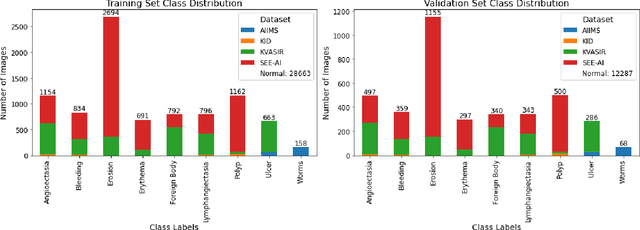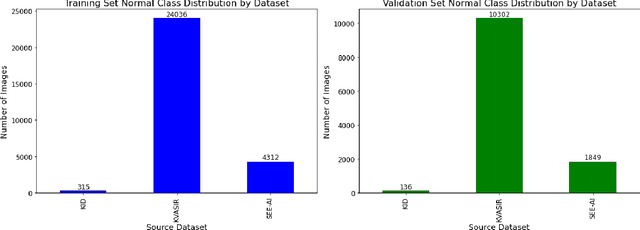Nidhi Goel
Artificial Intelligence in Gastrointestinal Bleeding Analysis for Video Capsule Endoscopy: Insights, Innovations, and Prospects (2008-2023)
Sep 01, 2024Abstract:The escalating global mortality and morbidity rates associated with gastrointestinal (GI) bleeding, compounded by the complexities and limitations of traditional endoscopic methods, underscore the urgent need for a critical review of current methodologies used for addressing this condition. With an estimated 300,000 annual deaths worldwide, the demand for innovative diagnostic and therapeutic strategies is paramount. The introduction of Video Capsule Endoscopy (VCE) has marked a significant advancement, offering a comprehensive, non-invasive visualization of the digestive tract that is pivotal for detecting bleeding sources unattainable by traditional methods. Despite its benefits, the efficacy of VCE is hindered by diagnostic challenges, including time-consuming analysis and susceptibility to human error. This backdrop sets the stage for exploring Machine Learning (ML) applications in automating GI bleeding detection within capsule endoscopy, aiming to enhance diagnostic accuracy, reduce manual labor, and improve patient outcomes. Through an exhaustive analysis of 113 papers published between 2008 and 2023, this review assesses the current state of ML methodologies in bleeding detection, highlighting their effectiveness, challenges, and prospective directions. It contributes an in-depth examination of AI techniques in VCE frame analysis, offering insights into open-source datasets, mathematical performance metrics, and technique categorization. The paper sets a foundation for future research to overcome existing challenges, advancing gastrointestinal diagnostics through interdisciplinary collaboration and innovation in ML applications.
WCEbleedGen: A wireless capsule endoscopy dataset and its benchmarking for automatic bleeding classification, detection, and segmentation
Aug 22, 2024



Abstract:Computer-based analysis of Wireless Capsule Endoscopy (WCE) is crucial. However, a medically annotated WCE dataset for training and evaluation of automatic classification, detection, and segmentation of bleeding and non-bleeding frames is currently lacking. The present work focused on development of a medically annotated WCE dataset called WCEbleedGen for automatic classification, detection, and segmentation of bleeding and non-bleeding frames. It comprises 2,618 WCE bleeding and non-bleeding frames which were collected from various internet resources and existing WCE datasets. A comprehensive benchmarking and evaluation of the developed dataset was done using nine classification-based, three detection-based, and three segmentation-based deep learning models. The dataset is of high-quality, is class-balanced and contains single and multiple bleeding sites. Overall, our standard benchmark results show that Visual Geometric Group (VGG) 19, You Only Look Once version 8 nano (YOLOv8n), and Link network (Linknet) performed best in automatic classification, detection, and segmentation-based evaluations, respectively. Automatic bleeding diagnosis is crucial for WCE video interpretations. This diverse dataset will aid in developing of real-time, multi-task learning-based innovative solutions for automatic bleeding diagnosis in WCE. The dataset and code are publicly available at https://zenodo.org/records/10156571 and https://github.com/misahub2023/Benchmarking-Codes-of-the-WCEBleedGen-dataset.
Capsule Vision 2024 Challenge: Multi-Class Abnormality Classification for Video Capsule Endoscopy
Aug 09, 2024



Abstract:We present the Capsule Vision 2024 Challenge: Multi-Class Abnormality Classification for Video Capsule Endoscopy. It is being virtually organized by the Research Center for Medical Image Analysis and Artificial Intelligence (MIAAI), Department of Medicine, Danube Private University, Krems, Austria and Medical Imaging and Signal Analysis Hub (MISAHUB) in collaboration with the 9th International Conference on Computer Vision & Image Processing (CVIP 2024) being organized by the Indian Institute of Information Technology, Design and Manufacturing (IIITDM) Kancheepuram, Chennai, India. This document describes the overview of the challenge, its registration and rules, submission format, and the description of the utilized datasets.
Reporting existing datasets for automatic epilepsy diagnosis and seizure detection
Jun 21, 2023Abstract:More than 50 million individuals are affected by epilepsy, a chronic neurological disorder characterized by unprovoked, recurring seizures and psychological symptoms. Researchers are working to automatically detect or predict epileptic episodes through Electroencephalography (EEG) signal analysis, and machine, and deep learning methods. Good quality, open-source, and free EEG data acts as a catalyst in this ongoing battle to manage this disease. This article presents 40+ publicly available EEG datasets for adult and pediatric human populations from 2001-2023. A comparative analysis and discussion on open and private EEG datasets have been done based on objective parameters in this domain. Bonn and CHB-MIT remain the benchmark datasets used for the automatic detection of epileptic and seizure EEG signals. Meta-data has also been released for large EEG data like CHB-MIT. This article will be updated every year to report the progress and changing trends in the development of EEG datasets in this field.
Open and free EEG datasets for epilepsy diagnosis
Aug 02, 2021Abstract:The Epilepsies are a common, chronic neurological disorder affecting more than 50 million individuals across the globe. It is characterized by unprovoked, recurring (similar or different type) seizures which are commonly diagnosed through clinical EEGs. Good-quality, open-access and free EEG data can act as a catalyst for on-going state-of-the-art (SOTA) research works for detection, prediction and management of epilepsy and seizures. They can also aid in improving the quality of life (QOL) of these diseased individuals and contribute research in healthcare multimedia, data analytics and Artificial Intelligence (AI) in personalized medicine. This paper presents widely used, available, open and free EEG datasets available for epilepsy and seizure diagnosis. A brief comparison and discussion of open and private datasets has also been done. Such datasets will help in development and evaluation of automatic computer-aided system in healthcare.
 Add to Chrome
Add to Chrome Add to Firefox
Add to Firefox Add to Edge
Add to Edge